Featured Stories
In the Midst of Plenty: A New Folk Musical
From the brochure: A new work of historical drama, set in 1847, at the height of Ireland’s Great Famine. Featuring an original score of contemporary acoustic folk music performed by a cast of professional actors and a live folk band, it tells the story of Bridget Connor, a tenant on the Strokestown estate, as she struggles to protect her family from the forces of starvation, eviction, and emigration.
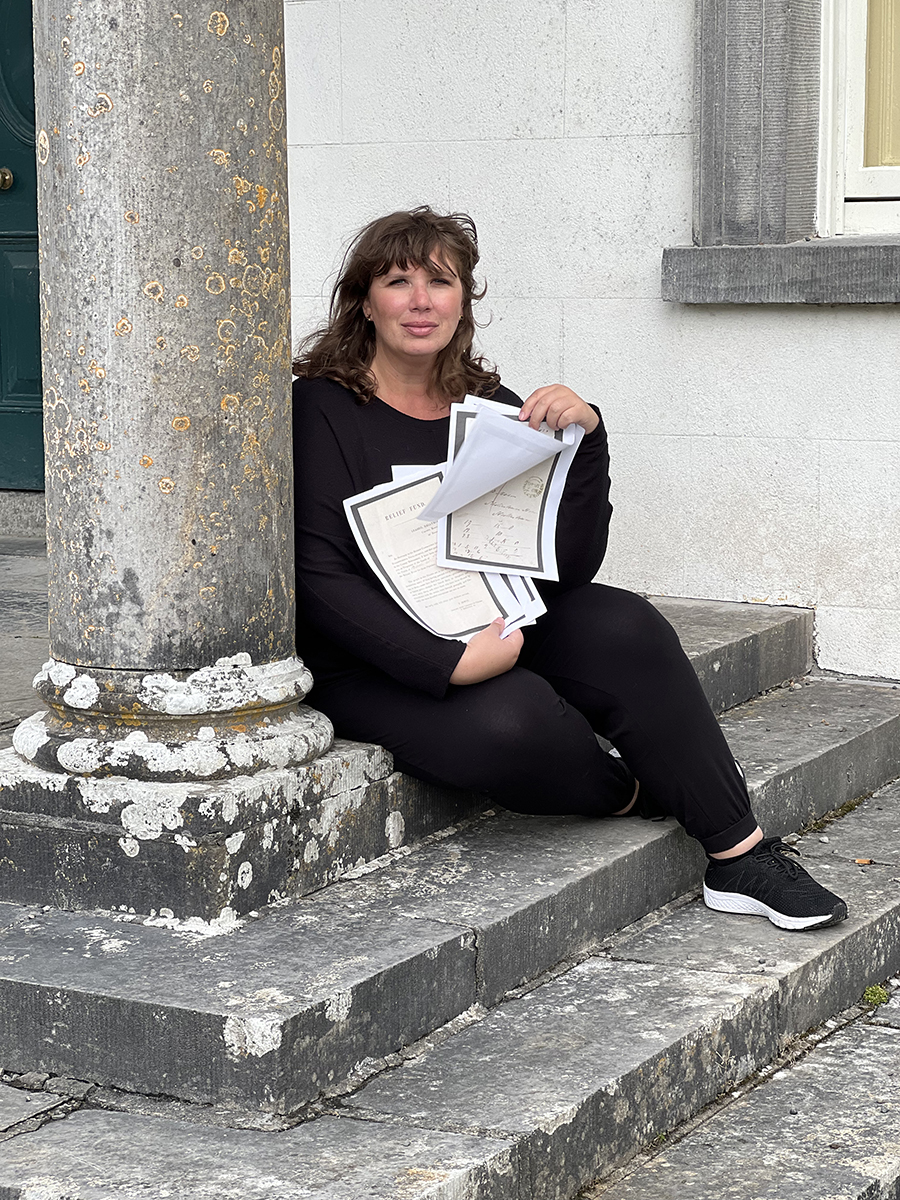
Amy Day, composer-lyricist, and music director of In the Midst of Plenty, on the steps of the National Famine Museum in Ireland.
To say I’m in awe of Amy Day, her talents, her tenacity and focus, and all she’s accomplished in a relatively short time, would be an understatement, but that’s where I’m going to start. You’re going to get to that same place by the time I’m done here.
After an admittedly hectic day for Amy, she and I sat down at my dining room table to talk about this venture. I was intrigued to hear it all—the process, the inspiration, and the ups and downs. Although the downs have been few, most have come from the internal questioning and self-doubt that plague so many of us as artists. This became part of her path to success.
Writing a musical had been on her to do list for a long time, and Day was on the lookout for just the right story, one that would be meaningful. Years before, she had been approached after a gig by local musician Sweet Joyce Ann who took her hands in hers and said, “You will write a musical.” Astonished at the prediction, Day felt it was an amazing spiritual moment and began to think about it more seriously, and although she happily continued to gig in bands, it was always in the back of her mind as something she wanted to pursue.
In the summer of 2019, Day, a law professor, was in Ireland to teach a one-month class at the Irish Center for Human Rights, which was part of a summer study abroad program that her school had in collaboration with the law school at National University of Ireland, Galway.
Day was immediately struck by the musical atmosphere in Ireland. “You’re kind of put into this non-stop musical space because it’s such an artistic place and there’s so much support for the arts, so much support for culture. It’s just a wonderful place to be.”
On a day trip to central Ireland’s County Roscommon, she visited the National Famine Museum. The estate had been owned by the Mahon family for centuries, from 1666 until 1980 when it was bought by the Callery family. Jim Callery subsequently discovered Irish famine-era documentation records and correspondence in the manor home. The estate had seen so much history, including the worst of Ireland’s Great Famine. Because of the wealth of information brought to light in those primary source records, the family turned it into a museum; now it’s called Ireland’s National Famine Museum.
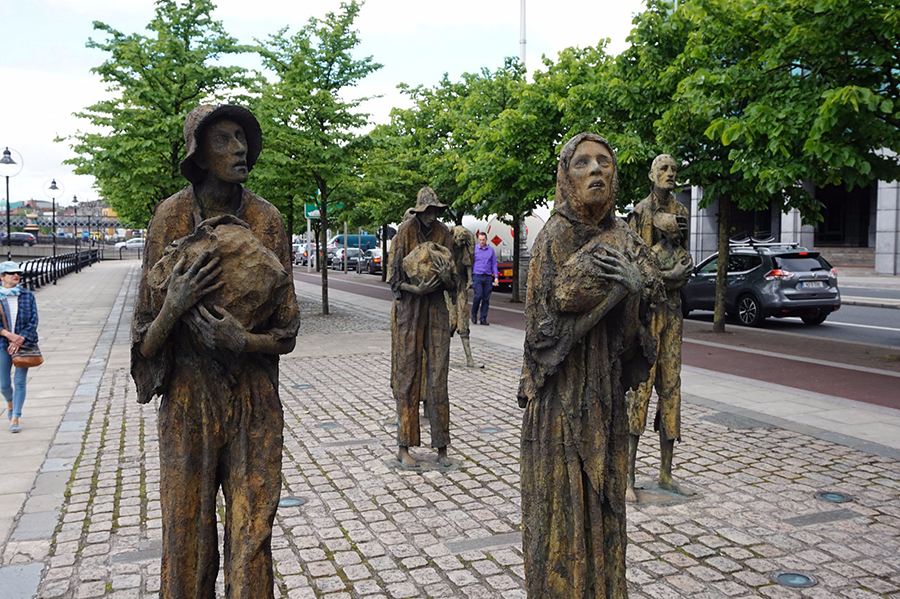
Famine sculptures in Dublin.
Going through the museum Day learned about what happened during the 1840s on the estate, to the tenant farmers, and about the assassination of the landlord. She was moved by the inherent drama of the story and began keeping songwriting notes, until a couple of months later she realized, “This isn’t one song. This is a musical.”
Day says, “It’s a period of history I will never get bored of learning about, and then it’s also a sonic landscape that I’m drawn to because it’s Ireland. It’s acoustic instrumentation, it’s 6/8 in E minor. I can mope along all I want and write all this sad stuff because of the subject matter. I can break out the accordion. All the instrumentation that I love is organically there. And, so, the story resonates with me, and the sound world-building landscape of what would be there fits me, and this is the kind of stuff I can make. That’s not to say that I was appropriating traditional Irish music, it’s a contemporary folk musical. It’s the kind of music I write but still it’s like the feeling is appropriate.”
Just as Day was starting to learn more about the period and figuring out who her characters would be, the pandemic hit. Surprisingly, this is when it turned around for her, and she admits that if she hadn’t been forced to be alone, she never would have taken the time to write. Her focus began to change and she found herself relating to the women and families she was learning about. As a then 38-year-old mother with three school-aged sons, it made sense to write a lead vocal for a grown woman, not for a man, such as the landlord, and not for a 19-year-old woman, but for an adult woman. She became enthralled with wanting to tell the stories of people who were mostly voiceless during that period, piecing those stories together, and telling what their experiences would have been.
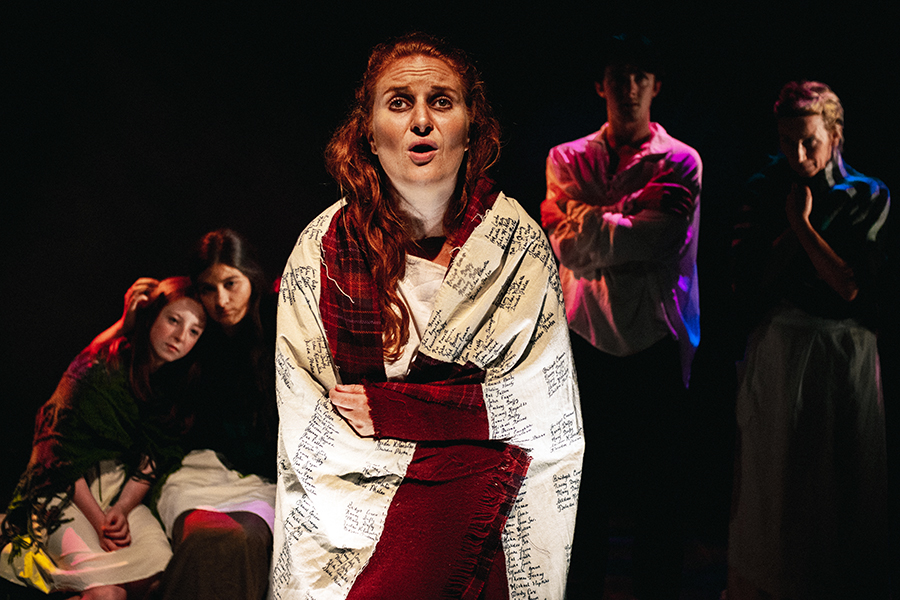
Actress Mary Claire Ryan, who plays the fictional character Mary in the play. Photo by Sean Casey.
From today’s perspective, Day wrote meaningful roles for adult women who are often overlooked and lack for opportunities in the performing arts. Hers is a woman’s story. The main character, Bridget Connor, is a figure of strength in her community; she’s funny, resourceful, and has to make some hard choices about how to support her friends and family. She struggles with moral questions and guilt. “So, the show is very heavy on her journey to process and forgive herself for the choice that she made in a situation where no one really had good choices to make,” Day says. “It sounds like a downer, but in a lot of ways, I think our audiences find it cathartic. I think because the story is true, there’s a universality to it that people just want to have that feeling, they just cry, but there’s still a lot of uplifting beauty to it in the way it’s performed.”
There is so much more to the history behind the musical, and I’m like Day when she said at one point, “I can geek out about the history at length…” I’ll put that part aside now to focus on the making, the discoveries and all that went into and came out of the project for just about everyone involved.
Through the writing process, Day discovered that she is a a private person. Comparing herself to other musicians, she realized that she just wasn’t drawn to exposing herself in song, to be that vulnerable, to share that much about herself. The format of the musical gave her a chance to explore not only what others could do musically but to also have access to their emotional stories. She found that freeing.

Actor Eoghan Burke, who portrays Father Michael McDermott in the play. Photo by Sean Casey.
So, she holed up in her bedroom to write, talking with historians online, reading like mad, working on demos with local music friends, and following everything online that was relevant to the story. Her pot of gold was connecting on social media with director Anne-Marie O’Sullivan, who was producing a digital theatre piece about the same family in Day’s play. When Day told O’Sullivan that she was writing a musical on the same topic, she thought she was joking, Day says, “because a famine musical sounds like the stupidest thing ever, it’s like potatoes and jazz hands!” After visiting Day’s website and hearing the demos, O’Sullivan applied for and received a grant to produce the show with local Irish actors and musicians.
The funding brought the whole thing into reality, but in fact Day had not yet finished writing it when the grant came in. That made it a little scary for her, yet she felt brave to be dreaming that big. She came to realize that “the only difference between a mediocre project and a great project is someone being brave enough to finish it.” Musing further, she said, “No idea is good until you’ve really, really worked it. It’s the same thing with songs in a band. Nothing comes good. It’s only as good or bad as people are brave enough to invest in making it the best it can be. I think a lot of people take a project only to the point where they start to feel insecure and then they walk away from it because it isn’t good. But if you can just be strong enough to keep going, you might be humiliated because it doesn’t work out or it might actually be good. You have to keep at it.”
Twos grants in 2022 funded three shows on the grounds of the National Famine Museum in June and two additional shows at the Roscommon Arts Center in September. All performances have been sold out and well received. So much so that now they are preparing to tour between May and July this year. They will be in every corner of Ireland in 12 venues and performing 17 shows.
Funding for the arts in Ireland includes a commitment to fair pay for artists. In the Midst of Plenty is a professional production with professional working actors who are paid properly according to Irish Actors Equity union rates, and the band, crew, set designers, and lighting technicians are all paid fairly. What a joy and relief to know that the production is fully paid. It frees everyone up to focus on their best performance in whatever capacity they are involved.
I’m getting ahead of myself, though. It’s important to note the preparation that came before all this success.
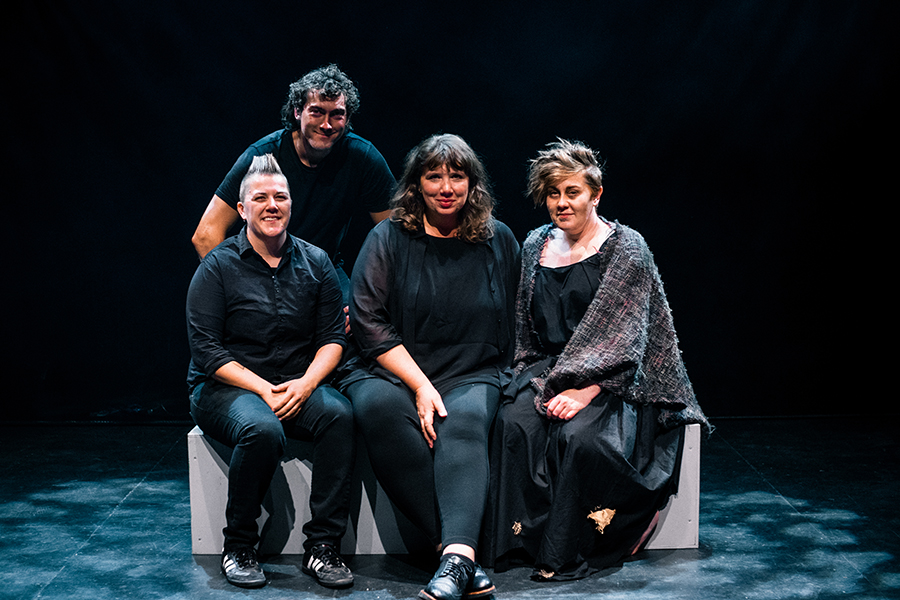
The band! San Diego-based drum legend and band leader Jules Stewart, renowned Irish trad fiddler Neil FitzGibbon, Amy, and acclaimed Irish nu-folk singer-songwriter Grainne Hunt.
For the song demos, Day utilized friends of hers, local talent, to make the recordings remotely. Jules Stewart, who Day says is “everybody’s drummer in San Diego,” played on all demos. In explaining how important drums are to the emotional trajectory in musical theatre, Day was grateful for Stewart’s innate sense of what was needed for each song. Jokingly, Day had said to Stewart, “Hey, if we ever get to go to Ireland with this show, do you want to come?” To which, Stewart answered, “Yeah, of course.” So that was it. Stewart was preordained as not just the drummer, she is also the bandleader. Days says, “She’s not just a really talented technical performer, she is also the person in the band who was just rock-solid smart, paying attention, lucid, sober, and clear-headed. She’s that person. So she has the whole script and she’s queuing all of our transitions, all of our songs.”
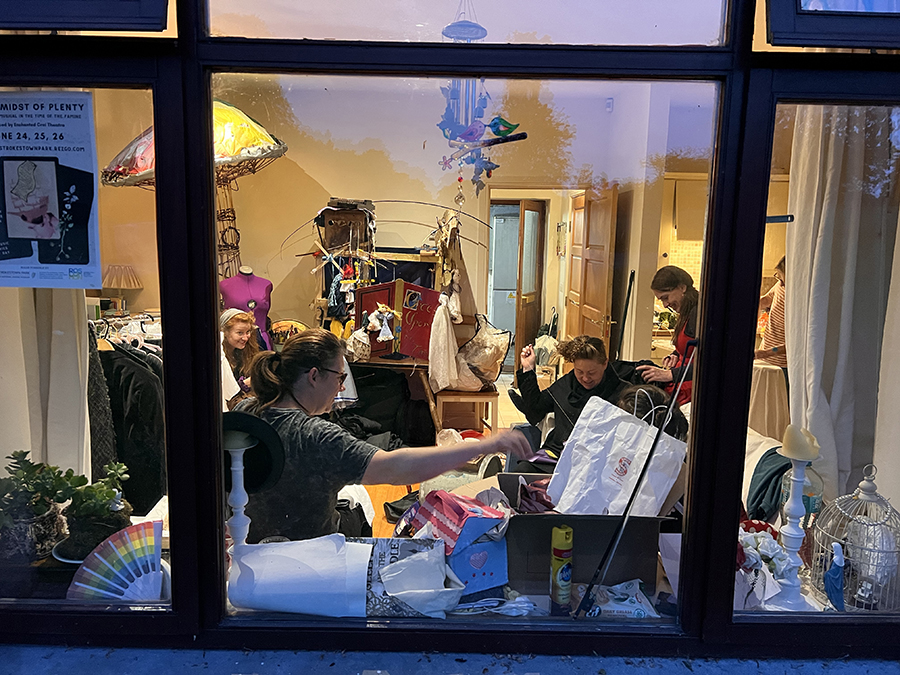
A view into the home of Anne-Marie O’Sullivan, where cast members and costumers work on preparation for the show.
Day is the writer, composer-lyricist, and music director, and plays the piano in the band. All other casting was done over Zoom. The auditions were a collaboration between director Anne-Marie O’Sullivan, who is from a traditional, professionally trained acting background, and Day, who is from more of a folk singer-songwriter musician background, and together, they chose people with crossover skills. Some of the cast are musicians who are now acting, and some are actors who are now singing. It includes acclaimed Irish nu-folk singer Grainne Hunt, who has recently opened for Declan O’Rourke and Glen Hansard; renowned Irish actress Julie Sharkey, who has done a lot of musical theatre; and prominent traditional Irish fiddler Neil FitzGibbon. It was important to Day to have cast members from the area. After a full-scale search for the right actors, she is happy to say, “Our cast has been really cohesive through all those shows in the fall and then to be headed out together on tour this year, it’s a really good group.”
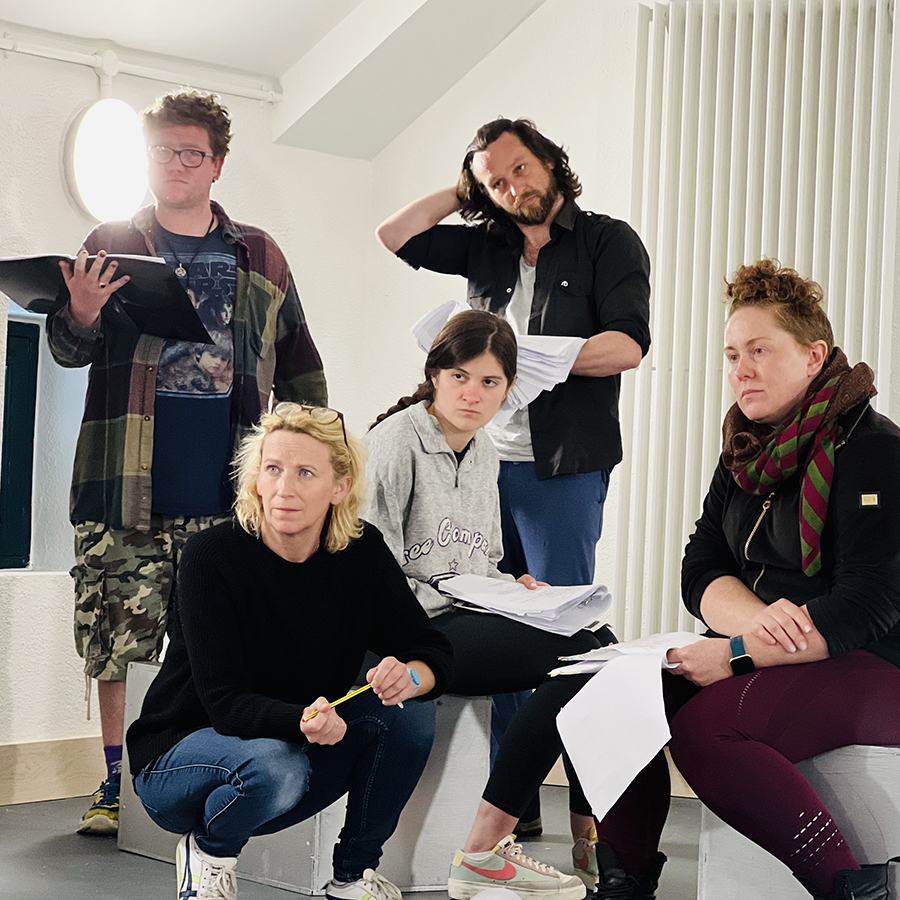
Cast members Gavin Sweeney, Julie Sharkey, Blathnaid Daly, Eoghan Burke, and Grainne Hunt in one of the first rehearsals.
The audience response has been overwhelming. People are deeply connected to the story on an emotional level. As an indie musician herself, Day has experience playing to empty rooms, but they have sold 700 tickets to this show. They have sold every seat and had waiting lists for every show. Day says, “One comment we get a lot is it would be nice if the lights could stay dark just a couple of extra minutes so I can collect myself at the end.” Day also shares, “For a lot of people we’re telling a story that’s part of their family’s history, that this happened in their family and they haven’t talked about it. And then for some people, it’s very much a motherhood story that she’s working to protect her kids, what wouldn’t you do for your kids? What choice would you not make for your kids? What wouldn’t you sacrifice for your kids? And so, you know, I think for a lot of parents also coming through the pandemic. You know, that’s not to equivocate that experience with this terrible period in Irish history, but it did make a lot of us think what wouldn’t we do for the people that we have to protect?”
Day’s personal experience and growth through all of this has been enormous. After her task of writing was done, it was time to hand the script over to people who would perform it. Up to that point, she had questioned herself, “Who am I to be writing an Irish story and performing in Ireland with phenominal Irish folk musicians?” She questioned the very concept of her story, her writing, the plot, and went through all that stuff that comes up from that not-so-nice place of self-doubt. But she found there was no room for her insecurity anymore because, “I realized once I got there and had the first couple of conversations with actors who are so vulnerable on stage doing this stuff, that I couldn’t sit there with them and be like, what about me? Yes, I was feeling all of that, but working with performers who had to perform it, you’re forced to get over that. You can’t say I’m sending you out on stage to perform trash, you just have to stop that kind of talk and then support them and what they need, which is a really good way to get over yourself.”
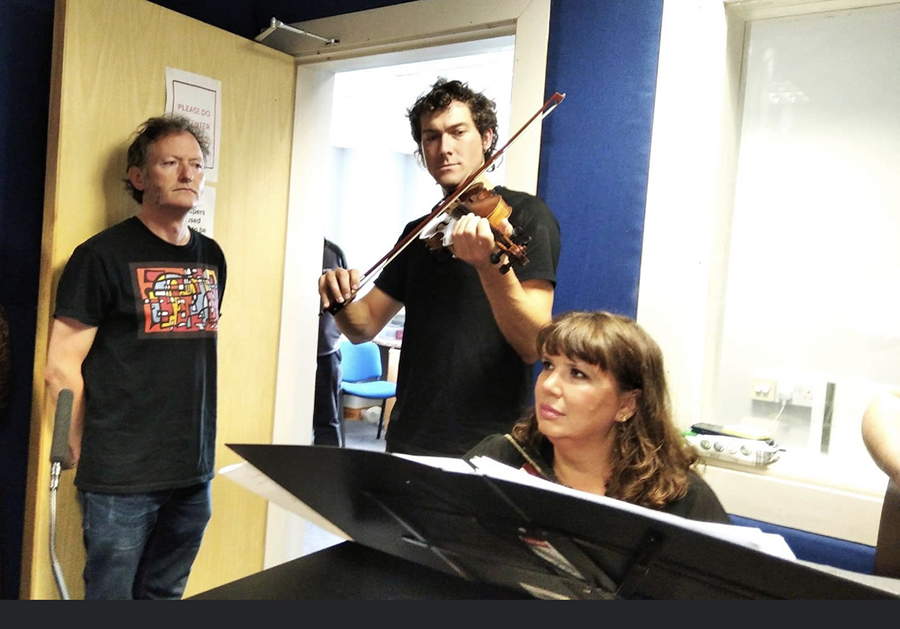
Actor Martin Gilligan, fiddler Neil FitzGibbon, and Amy Day in the radio studio at RosFM, in Roscommon, Ireland.
She has learned that if you are passionate about an idea, even if it seems strange, you will be able to find a group willing to go there with you. “I’ve learned that I can function on a lot less sleep than I thought I needed. I have learned to overcome my fear of flying. This is a great irony of my life that I’d have the two things I love the most in the world, separated by an 11-hour flight. I have learned what an incredible spouse I have. I have a spouse who is really, really free of jealousy, really free of competitiveness. And I think sometimes you don’t see that until you get really busy with a thing that matters to you and your spouse has to, you know, step up or not be into it.”
This whole project requires so much work, it’s more work in two time zones that Day ever could have imagined for herself. “This project consumes so much of my mental space, it’s just kind of where all my anxiety goes, it’s just to this. The work of it saves me for sure.”
In the past, Day was the type to have a lot of different interests going at one time, never focusing on one thing, so it’s been nice for her to discover that she is capable of a level of focus that has allowed her to finish this project. She says, “By virtue of having this project I now know how to create a website, or I’m learning how to use music transcription software, or there’s all these different skills that I think, especially as we get older, you need. You’re not in school anymore. You’re learning in a functional sense, and I think we have this real privilege when we work in the arts that we are forced to keep learning things that are very challenging in order to be working in that space.”
Having touched on the support of her husband, she elaborates, “My husband does not just support this work, he values it. And that’s the only reason that this is possible because when I was writing it alone he believed in it, he thought it was interesting, and he thought that it was worth pursuing and that I would not have completed the project if I did not have a spouse who was interested in talking about it. And not just like there, there, go do your hobby. He genuinely thinks that the story is worthwhile and that the piece is worthwhile and that the project is worthwhile.”
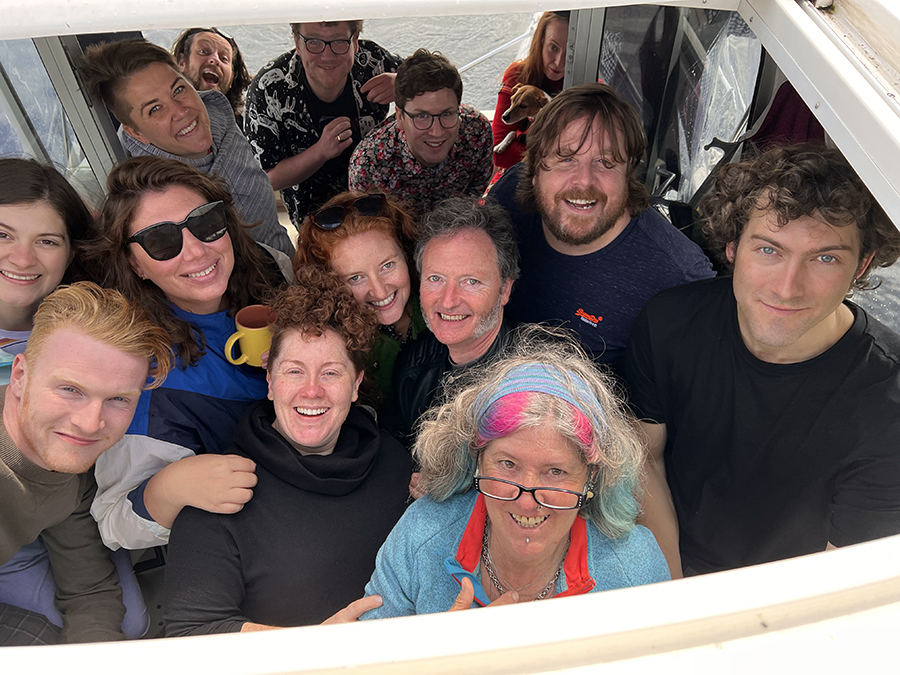
Cast members gather on the morning of the final show in Strokestown.
It was difficult for Day to be separated from her family, but it has helped her to bring her priorities into focus. Although she has to be gone, she now finds that when she is home it is more intrinsically about being home, not going out, not frittering away the time; she is deliberately and conciously spending it with her family. When not in school, her family has been able to join her in Ireland and gotten to know the community there and made friends. Day is grateful that they’ve been able to share the experience together. “It’s not without sacrifice,” she says, “I think I’m modeling something good for my kids, even though it does take me away from them for some time. I think that as mothers, we can lose ourselves in care for our children, we can lose our identities in putting our kids identities first. And I think it’s okay for my kids to see that I’m pursuing something that’s meaningful to me.”
Day happily states, “They’re very much involved. They were there for the workshopping, the music with our friends here, and they know the show. They’re involved in what’s happening from an administrative sense. And they get it from a musical sense, too. So, they feel ownership over the project as well.”
What would Day like to transplant to San Diego from Ireland? It would have to be the public support for the arts. Day shares, “Ireland does it really differently. It’s amazing what a government can do when the vast majority of its GDP isn’t going to fund the military industrial complex. Throughout history, Ireland has produced literature and drama and music and art that is world-class, second to none, because they invest in it at every level, and that’s remarkable.”
Day appreciates the supportive music community in San Diego. She says, “I think that this group of people really helps one another envision what they can do artistically, you know, whether it’s like Lindsay White creating Lady Brain or Unison Frances having the space for the songwriters book club. There’s just a lot of space here for people to explore their ideas and a lot of people are just really supportive of one another.” This project benefitted from that community. “The collaborators on demos, people who are performing parts and singing vocals, and things like that, it was definitely very much a function of being plugged in with this songwriting community in San Diego.”
The time I spent with Amy Day was a lesson in enthusiasm, history, gumption, and belief. I found her and her experience captivating and hope to one day visit Ireland to see In the Midst of Plenty for myself.
Learn more about the play, watch videos and hear the music, and fall in love with the production at www.inthemidstofplenty.com. Produced by the Enchanted Croi Theatre, their website is: www.enchantedcroi.ie






